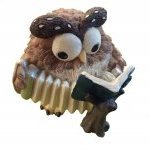-
Posts
337 -
Joined
-
Last visited
Profile Information
-
Gender
Male
-
Location
Iowa, USA
Recent Profile Visitors
2,906 profile views
Steve Schulteis's Achievements

Chatty concertinist (4/6)
-
.thumb.jpg.1dbd070a20a706d274d41ffeb11688ea.jpg)
For Sale: Lachenal 48-key treble English
Steve Schulteis replied to Steve Schulteis's topic in Buy & Sell
Price reduced to $1000, including shipping to lower 48 states. -
Really, kudos for making this silly idea a reality. Sorry if I came across as ungrateful.
-
I was hoping for some drones too (I'm just never satisfied, am I?), but I suppose those would have completely drowned out the melodica. Fun to see, all the same.
-
Take those small pipes and replace the chanter with a melodica to get some free reeds in the mix.
-
You may be out of space. Each user gets a relatively meager amount of storage for attachments, which is completely reasonable for the purpose of keeping down the costs for hosting the forum. You can check your available space here: https://www.concertina.net/forums/index.php?/attachments/ Most users deal with this by hosting files elsewhere and linking to them. I've used Google Drive and Photos for this in the past.
- 10 replies
-
- 1
-

-
- instrumental arrangement
- treble concertina
-
(and 1 more)
Tagged with:
-
.thumb.jpg.1dbd070a20a706d274d41ffeb11688ea.jpg)
Chords questions, notation, playstyle
Steve Schulteis replied to Victor F's topic in Teaching and Learning
When playing from the tabs in Gary's books, you don't need to worry about the chord symbols to begin with. Everything you need to play to sound like the youtube recordings is already captured in the button numbers, note durations, and bellows direction. The chords are a bit of extra description, explaining part of the outcome of playing the tabs. They can also be used as a starting point for developing your own harmonies. The way the chords are given isn't specific to concertina tabs - it's typical of lead sheets. When a chord is given, it's generally assumed to persist until a different chord is given. That doesn't mean you need to hold down all the notes of the chord for that entire time, but the harmony being played in that interval should generally support that chord. In the example you posted, the C chord is being played in an oom-pah style, alternating between the root note of the chord (left hand 3) and its remainder (left hand 4 & 5). And sometimes there's some cheating (or gaps in the chord notation, depending on your perspective), as in that pull 4 & 5 that aren't actually part of a C chord. As for the notes that make up a chord, yes a C chord is C-E-G, but it doesn't entirely matter which octave C, E, and G you play, and you can double up on any of them as well. That's what Gary's chart is showing - any combination of the buttons he's highlighted will sound like (or at least be compatible with) a C chord. You could add the left hand button 2 to the mix as well, but you'd need an extra finger to play all of those buttons at once! There are various reasons to pick different combinations of these notes when playing a chord, but the short version is that they sound different from each other while still sounding like the chord, and they give you options for moving smoothly (or not) between chords as well. If you want to get more specific than that, it's time to look for resources to learn some basic music theory. -
.thumb.jpg.1dbd070a20a706d274d41ffeb11688ea.jpg)
Nancy song music notation question
Steve Schulteis replied to Victor F's topic in Teaching and Learning
I agree completely. Anecdotally, I've found beginners to have no trouble with Coover tabs. I recently put my concertina in the hands of someone who had never handled one before, and with only a brief explanation they were able to decipher and slowly play a couple bars with harmonic tablature. This was followed by an enormous grin and hunt for a concertina to call their own. Individuals may have differing preferences (I'd make a few changes myself, given a time machine), but this system is good enough, and shared standards of communication are enormously valuable. -
Regarding the logic of the Anglo's layout, I'm not sure anyone has explicitly mentioned that the core 20 buttons use a variation of Richter tuning. To appreciate it, you need to think not just in melodies, but in chords. The apparent pattern break at the low end of the C row is to provide a low C chord on the push (actually an open fifth, since there isn't room for the E) and a low G chord on the pull. These are the two most important chords in the key of C major. So why not follow the same pattern on the G row? The answer is that button 6 would only have notes that are already available elsewhere (push G on button 2 and pull D on button 3). Replacing them with a couple of otherwise missing bass notes expands the range and harmony options of the instrument. I use button 6 on both the push and pull with reasonable frequency. The third row, filled with accidentals and reversals, also has a logic, but it's much less obvious from looking at it. If the 20 button layout is a donut, the 30 button's third row is the donut hole - a sort of negative image that shows what the original was missing. Note order is from low to high, just like the rest of the layout. Bellows direction is a function of what's harmonically convenient relative to the 20 button layout (and what fits). And some of it is a result of preference or the influence of different musical styles, as demonstrated by the existence of both Jeffries and Wheatstone layouts, as well as individual variations on them. Even so, most layouts stick pretty close to the same choices of notes and bellows directions, because that's where the music leads.
-
I'm not sure where people are finding G notes an octave apart on adjacent buttons in the same row. Could someone identify them using this button numbering system?
-
I'm listing this on behalf of a friend who is no longer able to play. Her desire is really for it to be played, so any reasonable offer will be considered. It's a lovely little instrument in good working order, featuring gold tooling on the bellows ends and silver inlay decorations. Located in central Iowa, USA; shipping included to lower 48 states. Hard case included. Asking $1000, reduced from $1274. Apologies for my inability to play English, here's a demonstration of bellows tightness and all notes on the push and pull:
-
.thumb.jpg.1dbd070a20a706d274d41ffeb11688ea.jpg)
Nancy song music notation question
Steve Schulteis replied to Victor F's topic in Teaching and Learning
The "1, 2 open rectangles" are to mark different endings for a repeated section of music. In this case, the second ending continues on into another section of the tune. https://www.studybass.com/lessons/reading-music/repeats-and-endings/ The italic 3 over some of the eighth notes indicates that those three notes are part of a triplet. Instead of taking a total of 1-1/2 beats like three eighth notes normally would, those three notes are played slightly quicker to only take one beat in total. https://www.studybass.com/lessons/rhythm/the-eighth-note-triplet-subdivision/ -
I just noticed that the button map you posted appears to be for a (modified?) Jeffries layout. If that's what you're playing, there are a couple uses of the right hand 2a button in my tablature that you'll have to replace, since I'm using the Wheatstone layout.
-
For some reason this tune captured my attention today, and I ended up tabbing out the whole thing. I did it pretty quickly, so double check for transcription errors on my part. Like Gary already pointed out, there are multiple options, and I picked buttons that I felt helped the phrasing as much as possible, but it's not the only way or even the "right" way. If you find my choices awkward or hard to play consistently, pick something that works for you. La Vie En Rose.pdf La Vie En Rose.mscz
-
.thumb.jpg.1dbd070a20a706d274d41ffeb11688ea.jpg)
Push pull change while on the same button
Steve Schulteis replied to latzenpratz's topic in Teaching and Learning
It's just above the staff, which is the convention for Coover tabs.








